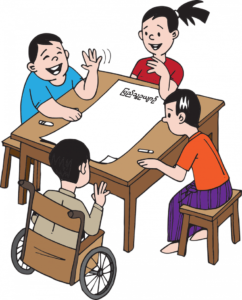According to Article 24 of the United Nations Conventions on the Rights of Persons with Disabilities, an inclusive education system should promote the full development of and sense of dignity and self-worth among students with disabilities. This usually comes from them being included in education, rather than just having access to education.
There is a difference between access to education and being included in education or inclusion in education. Some students have access to education but not inclusion in education. This is often the fate of students with disabilities as they are often and deliberately excluded in academic and extra curriculum activities by educators and their peers, even though they go to school. Such students may feel isolated and not part of the school community.

Students with disabilities need to have a sense of belonging in a school community to fully participate and excel in their education. This sense of belonging can be created by removing barriers that hinder their inclusion in education. These barriers are often both visible and invisible.
The visible barriers may include inaccessible classrooms, inaccessible toilets, non-inclusive teaching methods, textbooks in formats that are inaccessible to those with cognitive or visual impairments. Such barriers hinder students with disabilities’ participation in academic and extra curriculum activities. Decisive steps should be taken to remove these barriers to improve students with disabilities’ participation in academic and extra curriculum activities.
The invisible barriers may include discrimination, stigma, misconceptions, the perception that they are somehow less capable, seen as less valuable compared to their peers without disabilities. Such barriers affect students’ confidence and performance in the classroom. These barriers can be removed through disability awareness initiatives targeted at teachers and students without disabilities as well as specific training or skills development programs for teachers. Some students with disabilities may require psychosocial support and mentorship to build their confidence.
In conclusion, we should remove the visible and invisible barriers to promote the full development of and sense of dignity and self-worth among students with disabilities.

A fascinating discussion is worth comment. I do think that you ought to publish more about this issue, it may not be a taboo matter but typically folks dont speak about such topics. To the next! Cheers!!
Aw, this was a really nice post. In concept I would like to put in writing like this moreover – taking time and actual effort to make a very good article… however what can I say… I procrastinate alot and in no way appear to get one thing done.
Hello! I simply wish to give you a big thumbs up for your excellent information you have right here on this post. I will be returning to your web site for more soon.